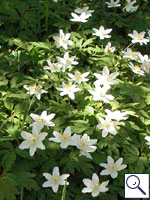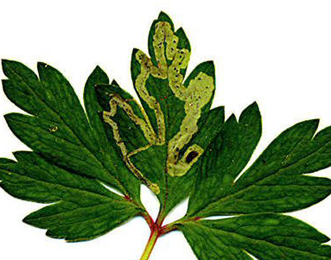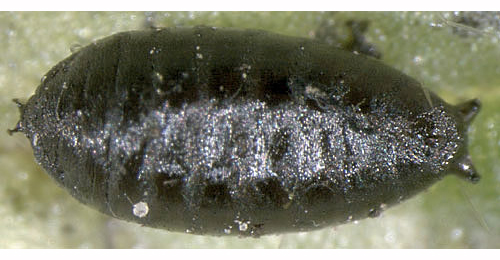|
||||||
|
ANEMONE. Anemones. [Ranunculaceae] |
|
|
Wood Anemone (A. nemorosa) is the only native species of Anemone recorded in Britain. Introductions include Blue Anemone (A. apennina), Balkan Anemone (A. blanda), Japanese anemone (A. hupehensis) and Yellow Anemone (A. ranunculoides). Three British miners are recorded on Anemone. A key to the European miners recorded on Anemone is provided in Bladmineerders van Europa.
|
 Wood Anemone Anemone nemorosa |
Key for the identification of the known mines of British |
1a > Leaf-miner: Mine linear but normally developing into secondary blotch, feeding confined to apex of a leaf segment (Spencer, 1972b: 70 (fig. 225); Spencer, 1976: 374, 375 (fig. 652)). Pupation normally external, but Lundquist (1947) records that 8 of 10 larvae pupariumted in the mine in Sweden. |
|
Phytomyza anemones Hering, 1925 [Diptera: Agromyzidae]. |
1b > Leaf-miner: Mine narrow, whitish, linear, normally adjoining margin of leaf; in small leaves can become blotch-like (Spencer, 1972b: 91 (fig. 305); Spencer, 1976: 427, 429 (fig. 746)). |
 Mine of Phytomyza hendeli on Anemone nemerosa Image: © Patrick Roper (British leafminers) |
|
Phytomyza hendeli Hering, 1923 [Diptera: Agromyzidae]. |
1c > Leaf-miner: Larva forms a conspicuous white linear mine with frass in closely adjoining grains. Pupation external (Spencer, 1972b:70 (figs 229-230A), 75; Spencer, 1976: 481, 483 (figs. 846, 848A)). Rather long, somewaht untidy, upper-surface corridor. Frass in many small grains that are close together of form pearl chains. Pupation outside the mine. The frass, in the long upper-surface white corridor, look like strings of pearls. P.ranunculivora makes similar long linear mines but in this species the frass grains are separate. The mine is also illustrated in the Encyclopedia of Life. |
 Phytomyza ranunculi puparium Image: © Willem Ellis (Bladmineerders van Europa) |
|
Phytomyza ranunculi (Schrank, 1803) [Diptera: Agromyzidae]. |
1c > Leaf-miner: Oviposition at the underside of a thick vein. From this point the larva makes a corridor that quickly widens into a full depth blotch, mostly in the distal half of the leaf. Frass initially in a central line, further on in scattered lumps. There is normally one mine per leaf. The larvae of sawflies have at least six thoracic legs (although they may be reduced or absent), a head capsule and chewing mouthparts with opposable mandibles but no abdominal legs. |
|
Endophytus anemones (Hering, 1925) [Hymenoptera: Tenthredinidae]. |
| Last updated 30-Jun-2019 Brian Pitkin | ||
